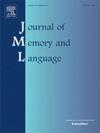零的阴影:区分不可能和不可想象
IF 3
1区 心理学
Q1 LINGUISTICS
引用次数: 0
摘要
有些事情是不可能的,但有些事情可能比不可能更不可能。在我们的世界里,用心灵悬浮一根羽毛是不可能的,但它符合我们对可能世界的直觉理论,而用数字5悬浮一根羽毛在任何可能的世界里都是不可能的(“不可思议”)。虽然之前的工作已经研究了不可能和不可能的事件之间的区别,但对不可思议性的实证研究却很少。在这里,我们调查人们是否保持不可能和不可想象之间的区别,以及如何做出这种区分。我们发现,人们可以很容易地区分不可能和不可思议,使用类似于用于调查不可能和不可能之间差异的分类研究(实验1)。然而,这种区别并不能用人们对事件可能性的主观评分来解释,它接近于零,无法区分不可能和不可思议的事件描述(实验2)。最后,我们询问统计语言模型(lm)分配给事件描述的概率是否可以用于分离模态类别,以及这些概率是否与人们的评级一致(实验3)。我们发现人和lm之间存在高度的相似性:两者都区分了不可能和不可思议的事件描述,并且lm派生的字符串概率预测了人们对跨模态类别的事件可能性的评级。我们的研究结果表明,关于极其罕见的事件(即不可能和不可思议的事件)的细粒度知识可以通过统计学习而不是语言形式来学习,然而,人们是否将不可能和不可思议之间的区别表示为程度上的差异,而是种类上的差异,这一问题仍未解决。本文章由计算机程序翻译,如有差异,请以英文原文为准。
Shades of zero: Distinguishing impossibility from inconceivability
Some things are impossible, but some things may be even more impossible than impossible. Levitating a feather using one’s mind is impossible in our world, but fits into our intuitive theories of possible worlds, whereas levitating a feather using the number five cannot be conceived in any possible world (“inconceivable”). While prior work has examined the distinction between improbable and impossible events, there has been little empirical research on inconceivability. Here, we investigate whether people maintain a distinction between impossibility and inconceivability, and how such distinctions might be made. We find that people can readily distinguish the impossible from the inconceivable, using categorization studies similar to those used to investigate the differences between impossible and improbable (Experiment 1). However, this distinction is not explained by people’s subjective ratings of event likelihood, which are near zero and indistinguishable between impossible and inconceivable event descriptions (Experiment 2). Finally, we ask whether the probabilities assigned to event descriptions by statistical language models (LMs) can be used to separate modal categories, and whether these probabilities align with people’s ratings (Experiment 3). We find high-level similarities between people and LMs: both distinguish among impossible and inconceivable event descriptions, and LM-derived string probabilities predict people’s ratings of event likelihood across modal categories. Our findings suggest that fine-grained knowledge about exceedingly rare events (i.e., the impossible and inconceivable) may be learned via statistical learning over linguistic forms, yet leave open the question of whether people represent the distinction between impossible and inconceivable as a difference not of degree, but of kind.
求助全文
通过发布文献求助,成功后即可免费获取论文全文。
去求助
来源期刊
CiteScore
8.70
自引率
14.00%
发文量
49
审稿时长
12.7 weeks
期刊介绍:
Articles in the Journal of Memory and Language contribute to the formulation of scientific issues and theories in the areas of memory, language comprehension and production, and cognitive processes. Special emphasis is given to research articles that provide new theoretical insights based on a carefully laid empirical foundation. The journal generally favors articles that provide multiple experiments. In addition, significant theoretical papers without new experimental findings may be published.
The Journal of Memory and Language is a valuable tool for cognitive scientists, including psychologists, linguists, and others interested in memory and learning, language, reading, and speech.
Research Areas include:
• Topics that illuminate aspects of memory or language processing
• Linguistics
• Neuropsychology.

 求助内容:
求助内容: 应助结果提醒方式:
应助结果提醒方式:


